The $60 CPU Question: AMD Athlon 200GE or Intel Pentium Gold G5400? A Review
by Ian Cutress on January 14, 2019 8:00 AM ESTCPU Performance: Rendering Tests
Rendering is often a key target for processor workloads, lending itself to a professional environment. It comes in different formats as well, from 3D rendering through rasterization, such as games, or by ray tracing, and invokes the ability of the software to manage meshes, textures, collisions, aliasing, physics (in animations), and discarding unnecessary work. Most renderers offer CPU code paths, while a few use GPUs and select environments use FPGAs or dedicated ASICs. For big studios however, CPUs are still the hardware of choice.
All of our benchmark results can also be found in our benchmark engine, Bench.
Corona 1.3: Performance Render
An advanced performance based renderer for software such as 3ds Max and Cinema 4D, the Corona benchmark renders a generated scene as a standard under its 1.3 software version. Normally the GUI implementation of the benchmark shows the scene being built, and allows the user to upload the result as a ‘time to complete’.
We got in contact with the developer who gave us a command line version of the benchmark that does a direct output of results. Rather than reporting time, we report the average number of rays per second across six runs, as the performance scaling of a result per unit time is typically visually easier to understand.
The Corona benchmark website can be found at https://corona-renderer.com/benchmark
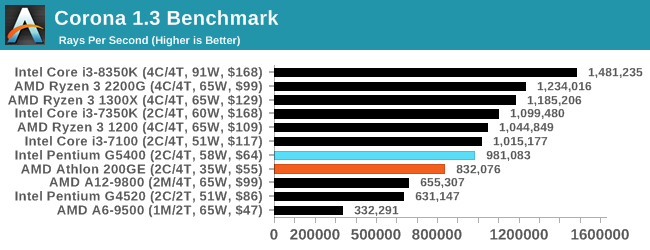
Corona is an all-threaded test, and Intel’s frequency advantage comes into play here with a 15% win.
Blender 2.79b: 3D Creation Suite
A high profile rendering tool, Blender is open-source allowing for massive amounts of configurability, and is used by a number of high-profile animation studios worldwide. The organization recently released a Blender benchmark package, a couple of weeks after we had narrowed our Blender test for our new suite, however their test can take over an hour. For our results, we run one of the sub-tests in that suite through the command line - a standard ‘bmw27’ scene in CPU only mode, and measure the time to complete the render.
Blender can be downloaded at https://www.blender.org/download/
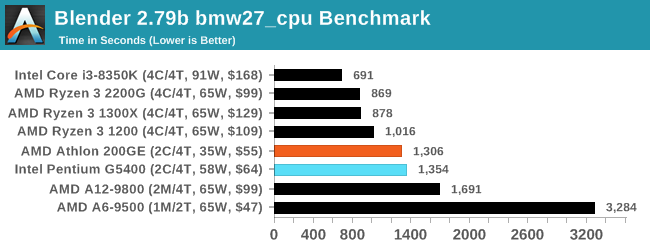
Blender also uses a mixed instruction workload, though not to the extent that our 3DPM and y-cruncher workloads do. But as with those tests, we get an AMD win of 3.7%.
LuxMark v3.1: LuxRender via Different Code Paths
As stated at the top, there are many different ways to process rendering data: CPU, GPU, Accelerator, and others. On top of that, there are many frameworks and APIs in which to program, depending on how the software will be used. LuxMark, a benchmark developed using the LuxRender engine, offers several different scenes and APIs.

Taken from the Linux Version of LuxMark
In our test, we run the simple ‘Ball’ scene on both the C++ and OpenCL code paths, but in CPU mode. This scene starts with a rough render and slowly improves the quality over two minutes, giving a final result in what is essentially an average ‘kilorays per second’.
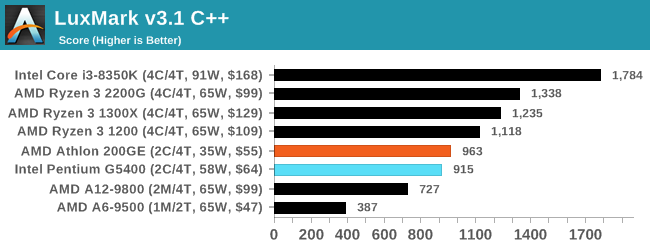
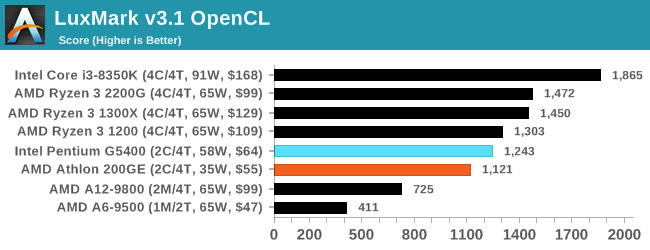
Interestingly we see AMD take the win for the C++ code by 5%, but Intel gets ahead with the OpenCL code (running purely on the CPU) by 10%.
POV-Ray 3.7.1: Ray Tracing
The Persistence of Vision ray tracing engine is another well-known benchmarking tool, which was in a state of relative hibernation until AMD released its Zen processors, to which suddenly both Intel and AMD were submitting code to the main branch of the open source project. For our test, we use the built-in benchmark for all-cores, called from the command line.
POV-Ray can be downloaded from http://www.povray.org/
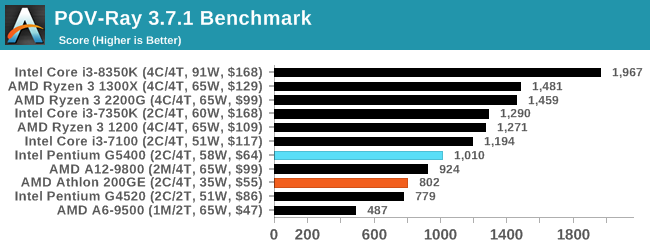
As another throughput test, here AMD is behind by 20%.











95 Comments
View All Comments
Irata - Tuesday, January 15, 2019 - link
The price push happened after the release - but do check Anandtech graphics cards reviews - they do have a tendency of mentioning current street / retail prices for both AMD and nVidia cards, which is how it should be.This is from the RX580 review:
"The biggest challenge right now is that GTX 1060 prices have come down to the same $229 spot just in time for the RX 500 series launch, so AMD doesn’t have a consistent price advantage"
yannigr2 - Tuesday, January 15, 2019 - link
Assimilator is a known Intel Nvidia hardcore fan. Ignore him.The_Assimilator - Wednesday, January 16, 2019 - link
Yes, pointing out facts makes me a fanboy. You a Trump voter by any chance?sonny73n - Tuesday, January 15, 2019 - link
@The_AssimiatorAre we not supposed to complain about the misleading pricing - one is Manufacturer’s SUGGESTED Retail Price and the ACTUAL price from the link provided by this article?
If I want to build a cheap office system NOW, should I take this article into consideration despite the huge price differences?
What’s special about the G5400 that its price has tripled due to “shortage”? At $182.68 currently from the link, is there no better CPU from Intel I can get for that price? Is Intel the only CPU manufacturer?
What are you trying to achieve by calling us name? What our criticism to AT has to do with you?
I’ve been restraining myself from criticizing AT too much. AT articles are slow to produce already. I wouldn’t want AT writers quit/fired then we’ll have less to read, even they’re written poorly.
kkilobyte - Tuesday, January 15, 2019 - link
What would have made the most sense is not writing such an article in the first place, then.I take Ian's own words on this: "I'm a big advocate of building a system piece by piece with the best you can afford at the time".
And at the (current) time, it seems that one simply cannot afford the G5400 for $64 (except maybe out of pure luck). This should have been, taken into account into the conclusion, or at least underlined.
AnnoyedGrunt - Tuesday, January 15, 2019 - link
Neither of these CPUs makes much sense. The G5400 isn't readily available (sold out on Newegg or only available from re-sellers for $100, as is the G5500 or G5600).Once you are spending $100, it makes much more sense to get the Ryzen 2200G for the same price that typically outperforms both of these (or only loses by a little to the G5400 in office type of tasks). The 2200G actually looks pretty decent as an IGP solution, and is a much better platform once you go to a dedicated GPU as well.
I'd personally work a few extra hours and save up for the 2200G over either of these options.
-AG
Valantar - Tuesday, January 15, 2019 - link
Despite all the complaints here of comparing products at very different price points (retail, not MSRP), I would still like to see a more complete test suite run on the overclocked 200GE, especially the gaming tests.Also, is iGPU overclocking possible on this chip, or are iGPU frequencies locked? It would also be very interesting for you to part out example builds of this vs. the G5400 and the Ryzen 3 2200G, to see the difference in actual system cost.
br83taylor - Tuesday, January 15, 2019 - link
Are those power figures correct? If you compare Ryzen 3 2200g for 20W and Ryzen 3 1300X at 58W. A third of the power but same 4C4T configuration.Zoolook13 - Tuesday, January 15, 2019 - link
For what it's worth, in Sweden the prices match pretty well 695 SEK for a 220GE vs 759 SEK for a G5400.Zoolook13 - Tuesday, January 15, 2019 - link
Sorry that ended up in the wrong place, edit button ftw...